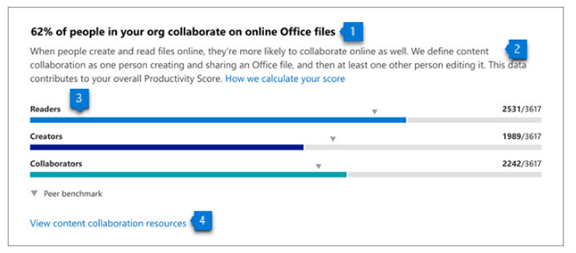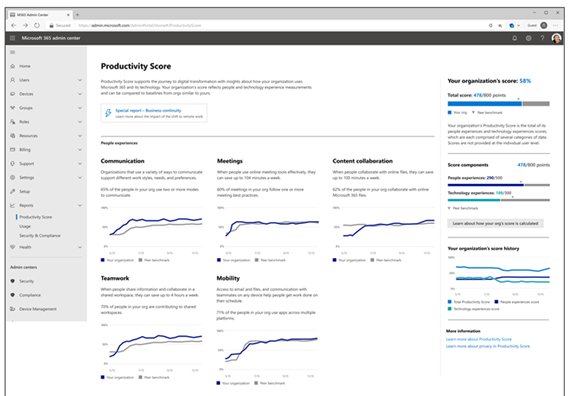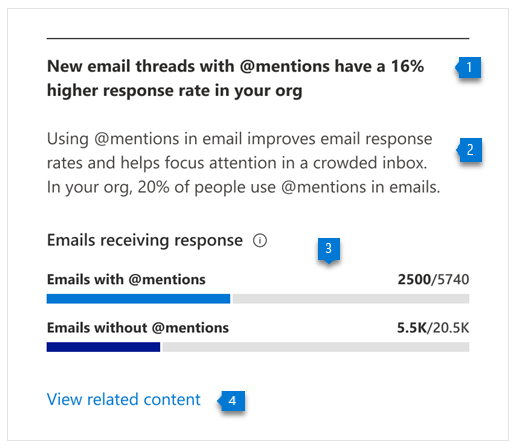Overview: Microsoft Productivity Score

These are just a few of the questions that managers often ask. If those managers look at the wrong things, that core paradigm gets in the way of empowering their team. For instance, nobody can grade productivity simply by “clock in/clock out” times.
In today’s hybrid and remote offices, the value and product an employee brings offers a better gauge. Nimble companies must look at obstacles for great employees trying to do great work.
Tools slow down dedicated workers who don’t know how to use those tools. Employees may be stuck in a rut, doing things the way they always have been, and fail to realize there is a better, faster, easier way.
But productivity’s often difficult to address. Micromanagement interferes with positive forward motion.
What’s the answer?
Microsoft 365 offers an integrated tool you can use to find nuggets of productivity gold. This tool is Microsoft Productivity Score.
What Does Microsoft Productivity Score Do?
Microsoft Productivity Score monitors core areas of your employees’ workflow in aggregate across your organization. Because it’s looking at your team as a whole instead of personal reports, employees don’t feel personally spied on.
The tool provides helpful insights to share with your staff. When distributed and properly used, these insights boost their performance. The program also includes hardware-related information. Use this information to discover whether your current company tools are holding people back.
MS Productivity Score monitors at the following areas.
People Experiences
This category looks at how people work together. Does your team use best practices for collaboration or are they going about it awkwardly? Do meetings continue forever? Do employees still email attachments with reply chains instead of using shared cloud storage links?
One example of an insight from this category to illustrate the process is that each employee can save an average of 100 minutes per week by collaborating with online files. Productivity Score shows you where your team stands in this metric, just for one example out of a plethora in this category.
Saving 100 minutes per week approximately equals 86.6 hours per year. That’s over 2 full workweeks in employee hours!

Subcategories within “people experiences” are:
- Communication
- Content collaboration
- Mobility
- Meetings
- Teamwork
Technology Experiences
Technology experiences monitor the health and performance of your devices. Is hardware and software on network endpoints that are causing issues? Is the technology slowing your team down? Can you find network connectivity problems? Are all apps updated as they should be for security and stability?
This category looks at the technology that your team works with and alerts you about any risk areas. When your tech isn’t running well or isn’t secure, your business slows down.
These three subcategories make up the technology experiences area:
- Endpoint analytics (You need Intune for these)
- Network connectivity
- Microsoft 365 apps health
Special Reports
Besides the people and technology experiences categories, there is one more area to monitor. Microsoft Productivity Score offers a special reports area. The purpose of special reports is to provide details on business continuity.
This report shows how employee collaboration and other activities change over time. The program collates these at these as the company goes through transitions. For instance, when you transition to remote working or back to in-office work. You can see how these changes impact your team’s productivity on an ongoing basis.

How Does Productivity Score Help Your Business
Automatic Metrics Tracking
Microsoft Productivity Score tracks any team’s use of Microsoft 365 applications automatically. The program then collates the data to provide helpful information on how team members use their digital tools.
These metrics offer a clear picture of whether employees are using best practices. Often, team members are doing their best and just need guidance to learn a more efficient way of doing something.
Insights to Understand the Data
The tool also provides helpful insights to understand the data. You won’t only get the team’s metrics; you’ll get the context. Context allows you to educate yourself as to what’s important and what isn’t. Then you can educate your employees on changes to improve workflow, save time, and accomplish more.
For example, getting a response quickly to a question saves valuable time. Many don’t realize that using @mentions can help achieve that. Productivity Score tells you how many people use @mentions in team communications, in addition to how much this practice increases the response rate.

Recommended Actions to Take
The third piece of guidance this program offers is what to do about the information. Productivity Score gives you actionable recommendations to improve a metric. Using these helps improve productivity.
The powerful combination of the metric, insight, and recommendation make this a comprehensive tool.
Why Is This Published By A Business Phone Company?
Here at NoContractVoIP, we believe that your success is our success. And, since we specialize in business communication, we also want to help you communicate better. We create the communication systems that modern companies need to adapt to the hybrid and remote business models. To get the latest helpful content delivered to your inbox every month, subscribe to our newsletter here.
Looking for the finest stress-free custom business telephone systems? Contact us or call today at 866-550-0005!
